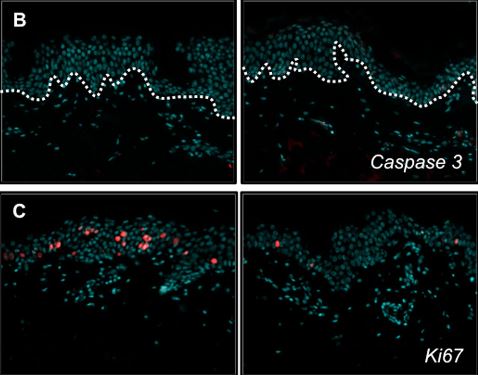Oxidative damage and impairment of protein quality control systems in keratinocytes exposed to a volatile organic compounds cocktail.
Marlène Dezest1, Mickael Le Bechec1, Laurent Chavatte1, Valérie Desauziers2, Benoît Chaput3, Jean-Louis Grolleau3, Pascal Descargues4, Carine Nizard5, Sylvianne Schnebert5, Sylvie Lacombe1 & Anne-Laure Bulteau
1IPREM, UMR 5254, Université de Pau et des Pays de l’Adour, Hélioparc, 2 Avenue Pierre Angot, 64000, Pau, France.
2Pôle RIME-C2MA, Ecole des mines d’Alès, Hélioparc, 2 Avenue Pierre Angot, 64053, Pau, France.
3Service dechirurgie plastique et reconstructrice, CHU de Toulouse Rangueil, 1, avenue Jean-Poulhès, 31400, Toulouse, France.
4Genoskin, Centre Pierre Potier, Oncopole, 31100, Toulouse, France.
5LVMH Recherche. Life Science Department,185 Avenue de Verdun, 45800, Saint Jean de Braye, France.
6Institut de Genomique Fonctionnelle de Lyon (IGFL),Ecole Normale Superieure (ENS) de Lyon-CNRS- UMR 5242, 46 Allee d’Italie, 69364 Lyon, France. Correspondenceand requests for materials should be addressed to A.-L.B. (email:anne-laure.bulteau@ens-lyon.fr
)
Compelling evidence suggests that volatile organic compounds (VOCs) have potentially harmful effects to the skin. However, knowledge about cellular signaling events and toxicity subsequent to VOC exposure to human skin cells is still poorly documented.
The aim of this study was to focus on the interaction between 5 different VOCs (hexane, toluene, acetaldehyde, formaldehyde and acetone) at doses mimicking chronic low level environmental exposure and the effect on human keratinocytes to get better insight into VOC-cell interactions.
We provide evidence that the proteasome, a major intracellular proteolytic system which is involved in a broad array of processes such as cell cycle, apoptosis, transcription, DNA repair, protein quality control and antigen presentation, is a VOC target. Proteasome inactivation after VOC exposure is accompanied by apoptosis, DNA damage and protein oxidation. Lon protease, which degrades oxidized, dysfunctional, and misfolded proteins in the mitochondria is also a VOC target.
Using human skin explants we found that VOCs prevent cell proliferation and also inhibit proteasome activity in vivo. Taken together, our findings provide insight into potential mechanisms of VOC-induced proteasome inactivation and the cellular consequences of these events.
Upload the article:
1IPREM, UMR 5254, Université de Pau et des Pays de l’Adour, Hélioparc, 2 Avenue Pierre Angot, 64000, Pau, France.
2Pôle RIME-C2MA, Ecole des mines d’Alès, Hélioparc, 2 Avenue Pierre Angot, 64053, Pau, France.
3Service dechirurgie plastique et reconstructrice, CHU de Toulouse Rangueil, 1, avenue Jean-Poulhès, 31400, Toulouse, France.
4Genoskin, Centre Pierre Potier, Oncopole, 31100, Toulouse, France.
5LVMH Recherche. Life Science Department,185 Avenue de Verdun, 45800, Saint Jean de Braye, France.
6Institut de Genomique Fonctionnelle de Lyon (IGFL),Ecole Normale Superieure (ENS) de Lyon-CNRS- UMR 5242, 46 Allee d’Italie, 69364 Lyon, France. Correspondenceand requests for materials should be addressed to A.-L.B. (email:anne-laure.bulteau@ens-lyon.fr









 Follow us on Linkedin!
Follow us on Linkedin!